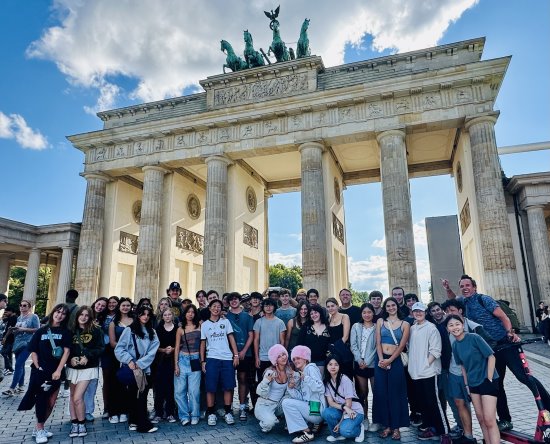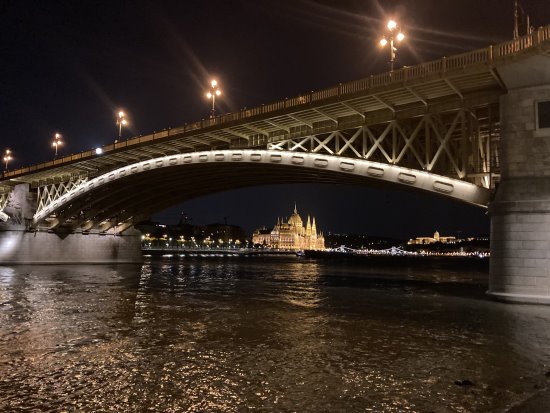 | | | Students and instructors in front of the Brandenburg Gate - Berlin, Germany. Photo Annie Strickler | | | | | | From July 12 through 21, a band of 35 Miramonte students embarked on an educational journey to Berlin, Prague, Krakow, and Budapest. Across the Atlantic, these Eastern European cities offered striking beauty and miles of history.?
 The trip was led by history instructors Xavier Frippiat, Kelly Ginocchio, and Matt Sweeney. Frippiat has guided Miramonte students five times before to cities across Europe. "This year, I seized the opportunity to appeal to students' sense of adventure," Frippiat said. "I planned an itinerary less frequented by folks in our community: Eastern Europe. I framed it as: `Discover the Europe your Friends Haven't Seen Yet!'"?
The trip was led by history instructors Xavier Frippiat, Kelly Ginocchio, and Matt Sweeney. Frippiat has guided Miramonte students five times before to cities across Europe. "This year, I seized the opportunity to appeal to students' sense of adventure," Frippiat said. "I planned an itinerary less frequented by folks in our community: Eastern Europe. I framed it as: `Discover the Europe your Friends Haven't Seen Yet!'"?
 Priority was granted to students who had completed the AP European History course. "All the places we visit are oozing with historical relevance from multiple periods, something students who engaged with AP European History can attest to," Frippiat said.
Priority was granted to students who had completed the AP European History course. "All the places we visit are oozing with historical relevance from multiple periods, something students who engaged with AP European History can attest to," Frippiat said.
 The trip drew students ranging from rising juniors to freshly graduated seniors. "I decided to attend because I love traveling and seeing other parts of the world. I also don't think I will ever have the chance to go on another trip like this with my friends," graduated senior Ryan Sinnreich said.
The trip drew students ranging from rising juniors to freshly graduated seniors. "I decided to attend because I love traveling and seeing other parts of the world. I also don't think I will ever have the chance to go on another trip like this with my friends," graduated senior Ryan Sinnreich said.
 After an overnight flight, students and teachers arrived in Berlin, where they met their Tour Director, courtesy of the travel agency EF Tours, and checked in to the first of four hotels. A typical day was filled to the brim with activities. Students would wake up early, eat a hotel breakfast, and then take a bus ride into the city, where a walking tour was held. On longer travel days, like the one from Krakaw to Budapest, students would be on the bus for up to seven hours, winding through countryside such as the Tatra Mountains.
After an overnight flight, students and teachers arrived in Berlin, where they met their Tour Director, courtesy of the travel agency EF Tours, and checked in to the first of four hotels. A typical day was filled to the brim with activities. Students would wake up early, eat a hotel breakfast, and then take a bus ride into the city, where a walking tour was held. On longer travel days, like the one from Krakaw to Budapest, students would be on the bus for up to seven hours, winding through countryside such as the Tatra Mountains.
 Still, a flexible curfew allowed students to explore. "After dinner, my friends and I would go out at night for fun. We would only stay in one city for two days, so you had to make the most out of your time there," incoming junior Margaret Meckes said.
Still, a flexible curfew allowed students to explore. "After dinner, my friends and I would go out at night for fun. We would only stay in one city for two days, so you had to make the most out of your time there," incoming junior Margaret Meckes said.
 With a roster of nearly 40 people, students learned discipline when traveling in groups. Should they choose to split up, teens were trusted to be responsible for everything, from their belongings to their time. "We had to rely on ourselves to navigate and find food or entertainment," rising junior Annie Strickler said. "It developed our independence."
With a roster of nearly 40 people, students learned discipline when traveling in groups. Should they choose to split up, teens were trusted to be responsible for everything, from their belongings to their time. "We had to rely on ourselves to navigate and find food or entertainment," rising junior Annie Strickler said. "It developed our independence."
 "I found the group to be very respectful of the adult chaperones and places we visited," Frippiat said. "I had the graduated seniors as former students, so I trusted them a great deal."
"I found the group to be very respectful of the adult chaperones and places we visited," Frippiat said. "I had the graduated seniors as former students, so I trusted them a great deal."
 With most students unable to speak German, Polish, Hungarian, or Czech, language barriers posed challenges when interacting with locals. Still, the spirit of travel prevailed, teaching students how to adapt. "Being somewhere where people don't share your language gives you a new perspective," Strickler said. "It can help you understand people in your own country once you return home."
With most students unable to speak German, Polish, Hungarian, or Czech, language barriers posed challenges when interacting with locals. Still, the spirit of travel prevailed, teaching students how to adapt. "Being somewhere where people don't share your language gives you a new perspective," Strickler said. "It can help you understand people in your own country once you return home."
 Each walking tour promised something new. Students toured Germany's magnificent Dresden Castle, admired the Saints Peter and Paul Church in Krakaw, and snapped photos of Budapest's Margaret Bridge at night. For those who had taken AP European History, this trip made the images they'd only seen in textbooks spring to life. Being able to physically touch the Berlin Wall was a highlight for many. "I'm grateful I got this opportunity to tour the Berlin Wall remains, Brandenburg Gate, and St. Mary's Basilica," graduated senior Olivia Lee said.
Each walking tour promised something new. Students toured Germany's magnificent Dresden Castle, admired the Saints Peter and Paul Church in Krakaw, and snapped photos of Budapest's Margaret Bridge at night. For those who had taken AP European History, this trip made the images they'd only seen in textbooks spring to life. Being able to physically touch the Berlin Wall was a highlight for many. "I'm grateful I got this opportunity to tour the Berlin Wall remains, Brandenburg Gate, and St. Mary's Basilica," graduated senior Olivia Lee said.
 Yet amid exciting learning experiences, students also grappled with heavy historical legacies, particularly those of the Holocaust and Nazi occupation. Upon arriving in Berlin, students visited the Topography of Terror Museum, the former headquarters of the Nazis' Schutzstaffel (SS) military group during World War II. A week in, the group traveled to Krakaw and took a guided tour of the Auschwitz and Birkenau concentration camps.
Yet amid exciting learning experiences, students also grappled with heavy historical legacies, particularly those of the Holocaust and Nazi occupation. Upon arriving in Berlin, students visited the Topography of Terror Museum, the former headquarters of the Nazis' Schutzstaffel (SS) military group during World War II. A week in, the group traveled to Krakaw and took a guided tour of the Auschwitz and Birkenau concentration camps.
 "I found the Auschwitz tour most memorable: the exhibits were filled with prisoners' old clothes, shoes, and briefcases," Lee said. "Seeing the sheer amount of items left behind put the scale of the Holocaust into perspective."
"I found the Auschwitz tour most memorable: the exhibits were filled with prisoners' old clothes, shoes, and briefcases," Lee said. "Seeing the sheer amount of items left behind put the scale of the Holocaust into perspective."
 The gravity of such experiences proved eye-opening to every student. "It's critical for young people to be exposed to the failures of the past so we ensure history doesn't repeat itself," Lee said.
The gravity of such experiences proved eye-opening to every student. "It's critical for young people to be exposed to the failures of the past so we ensure history doesn't repeat itself," Lee said.
 With these lessons in mind, students experienced each country's vibrant diversity and heritage. "Through Krakow's Kazimierz district, we learned a lot about Jewish history: not just as in World War II, but also everyday life there," graduated senior Mika Strickler said.
With these lessons in mind, students experienced each country's vibrant diversity and heritage. "Through Krakow's Kazimierz district, we learned a lot about Jewish history: not just as in World War II, but also everyday life there," graduated senior Mika Strickler said.
 Moreover, current events charged cities full of vigor, like in Berlin. "I'd pick Berlin as my favorite because of its bike friendliness, many public parks, and the energy of the Euro Cup Final happening then," Frippiat said. "It had countless cafés and beer gardens at every turn."
Moreover, current events charged cities full of vigor, like in Berlin. "I'd pick Berlin as my favorite because of its bike friendliness, many public parks, and the energy of the Euro Cup Final happening then," Frippiat said. "It had countless cafés and beer gardens at every turn."
 Of course, the cuisine was delectable. In fact, some students tasted a crossroads of cultures. "To be honest, my favorite food we had in Europe was this sushi pizza in Dresden, Germany. I loved the crispy rice crust," Mika Strickler said.
Of course, the cuisine was delectable. In fact, some students tasted a crossroads of cultures. "To be honest, my favorite food we had in Europe was this sushi pizza in Dresden, Germany. I loved the crispy rice crust," Mika Strickler said.
 These nine dynamic days have shaped a summer to remember, especially for seniors capping off their high school years. "I loved watching the sunset over the Prague skyline while sipping on cider and zooming around the city on Lime scooters," Lee said.
These nine dynamic days have shaped a summer to remember, especially for seniors capping off their high school years. "I loved watching the sunset over the Prague skyline while sipping on cider and zooming around the city on Lime scooters," Lee said.
 "My friends and I visited an amusement park in Krakow, where we rode a Ferris wheel and got a beautiful view of the city and the Danube River," Mika Strickler said. "It was unforgettable."
"My friends and I visited an amusement park in Krakow, where we rode a Ferris wheel and got a beautiful view of the city and the Danube River," Mika Strickler said. "It was unforgettable."
 The beauty of Europe, and the memories made there, will be cherished by these students,?especially because they've shared this adventure together.?
The beauty of Europe, and the memories made there, will be cherished by these students,?especially because they've shared this adventure together.?
 "When young adults travel abroad, they are given a different perspective of the world and a broader array of what is possible," Frippiat said. "Traveling abroad sets the groundwork for many more adventures and explorations in their lifetime."
"When young adults travel abroad, they are given a different perspective of the world and a broader array of what is possible," Frippiat said. "Traveling abroad sets the groundwork for many more adventures and explorations in their lifetime." |


